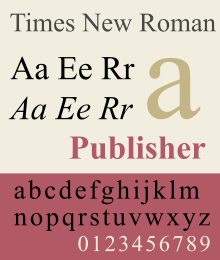Times New Roman
 |
|
| Category | Serif |
|---|---|
| Classification | Mixed Transitional Old-style |
| Designer(s) |
Stanley Morison Victor Lardent |
| Commissioned by | The Times |
| Foundry | Monotype |
| Date released | 1932 |
| License | Proprietary |
| Design based on | Plantin |
Times New Roman is a serif typeface commissioned by the British newspaper The Times in 1931 and designed by Stanley Morison, an advisor to the British branch of the printing equipment company Monotype, in collaboration with Victor Lardent, an artist in the Times' advertising department. Although no longer used by The Times, Times New Roman is still very common in book and general printing. Through distribution as a standard computer font, it has become one of the most widely used typefaces in history.
Times New Roman's creation took place through the influence of Stanley Morison of Monotype. Morison was an artistic director at Monotype, historian of printing and informal adviser to The Times, who recommended that they change typeface from the spindly and somewhat dated nineteenth-century Didone typeface previously used to a more robust, solid design, returning to traditions of printing from the eighteenth century and before. This matched a common trend in printing of the period.
Morison proposed an older Monotype typeface named Plantin as a basis for the design, but revisions were made to increase legibility and economy of space. In particular, contrast between strokes was enhanced to give a crisper image. The new font was drawn by Victor Lardent, an artist from the advertising department of The Times, with Morison consulting, before refinement by the Monotype drawing office. The new design made its debut in The Times on 3 October 1932. After one year, the design was released for commercial sale.The Times stayed with Times New Roman for 40 years, but new production techniques and the format change from broadsheet to tabloid in 2004 have caused the newspaper to switch typeface five times from 1972 to 2007. However, all the new fonts have been variants of the original New Roman typeface. In commercial sale, Times New Roman became extremely successful, becoming Monotype's best-selling typeface of all in metal type. Although Morison may not have literally drawn the design, his influence on its concept was sufficient that he felt that he could take credit for it as "my one effort at designing a font".
...
Wikipedia
